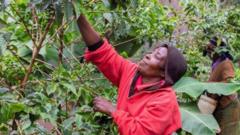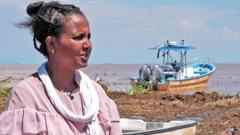Kenyan coffee farmers, renowned for their quality produce, are battling climate change impacts that threaten their way of life and the future of the iconic industry.
Kenya’s Coffee Industry Faces Climate Crisis: Farmers Struggle

Kenya’s Coffee Industry Faces Climate Crisis: Farmers Struggle
As Kenyan coffee farmers confront the harsh realities of climate change, their livelihoods and the quality of "black gold" are at stake.
In the idyllic coffee-producing region of Komothai, located in Kenya's Rift Valley, Simon Macharia and fellow farmers work diligently on their small plantations, carrying bright red coffee cherries to local processing facilities. The celebrated Kenya AA coffee beans, known for their exceptional quality and rich flavors, have been cultivated here since the late 19th century, following their introduction by British colonial settlers. However, this cherished crop faces unprecedented challenges.
Macharia's farm spans 2.5 hectares (about six acres), and he describes the labor-intensive process involved in growing coffee, which requires meticulous care and constant attention. Harvesting these beans is particularly demanding, and farmers put in tireless hours to ensure the crop flourishes. However, the economic disparities are stark—they often earn less than a cup of coffee sold in European cafés, which can average around $4 (£3.20). Many, like coffee picker Edita Mwangi, endure long hours for meager wages, struggling to provide for their families.
The coffee trading system between Kenya and Europe has historically favored the market, further compounding the difficulties for the farmers. Now, climate change presents an additional existential threat. Coffee, being a delicate crop, is highly sensitive to temperature fluctuations and weather patterns, which are becoming increasingly erratic. John Murigi, chairman of the Komothai Coffee Society, which aids over 8,000 local farmers, highlighted the negative impacts of fluctuating temperatures and changing precipitation on coffee output. These changes, he said, have made coffee production increasingly precarious.
Farmers are also witnessing a rise in pests and diseases exacerbated by climate change, including coffee leaf miners and a destructive fungal condition called coffee berry disease, which can decimate entire crops. To combat these challenges, farmers resort to potentially harmful pesticides, putting their health and the environment at risk.
The allure of the coffee industry is further tempered by the critical water shortage affecting the Rift Valley, where higher temperatures and sporadic rains impede water supply. With declining river levels, water management has become a pressing concern, making it difficult for farmers to meet the needs of their crops—and exacerbating the strain on local water resources.
At a global level, rising temperatures are predicted to make coffee cultivation increasingly difficult, with impacts felt across the coffee-producing belt. A Fairtrade International survey indicated that a staggering 93% of Kenyan coffee farmers have already noted adverse effects from climate change. This vital sector provides employment for about 150,000 people, making its survival essential for community welfare.
To combat climate challenges, initiatives such as planting shade trees are being introduced, but many farmers remain skeptical about the long-term viability of their industry. As Macharia expressed a sense of hopelessness, he reflected, “Right now, as things stand, I don't think any parent wants their child here farming coffee.”
The journey for Kenyan coffee farmers is steep, as they navigate both climatic hurdles and economic hardship in striving to secure a future for this invaluable industry.




















